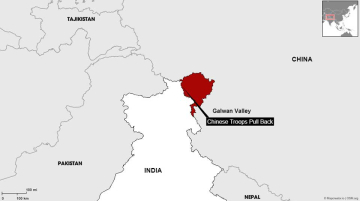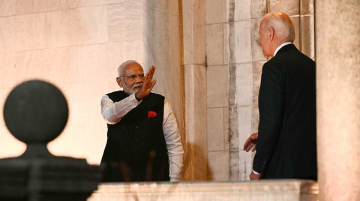
In October 2024, after nearly four years of diplomatic parleys, India and China reached an agreement on multiple border posts along the Line of Actual Control (LAC), the de facto border between the two countries.
The agreement allows the disengagement of troops from the highly contentious friction points in Depsang and Demchok. It also allows soldiers from both sides to undertake coordinated patrolling in these two areas to prevent further tensions and hostilities.
With this, at least temporarily, the heightened emotions about the territory claimed along the LAC by the two countries have been calmed somewhat.
However, the Sino-Indian border breakthrough is unlikely to resolve the border dispute and border tensions. It is quite likely that the tensions will continue to persist.
The recent border tensions began in May 2020 with Chinese intrusions at multiple points along the LAC. Multiple explanations have been provided for China’s actions, which encompass a broad spectrum. They include domestic problems in China (slowdown in China’s economy and COVID-19-induced vulnerability) and a loss of status in global affairs.
Some developments in India were also seen as a provocation by China, such as the sudden bifurcation of the erstwhile state of Jammu and Kashmir into two centrally governed union territories – J&K and Ladakh, which borders China – Home Minister Amit Shah’s statement regarding restoring Pakistan Occupied Kashmir and Aksai Chin as parts of India, the rapid infrastructure build-up by India along the disputed border, and its burgeoning relations with the United States.
In June 2020, Indian and Chinese troops clashed in the Galwan Valley, leading to casualties on both sides for the first time in nearly 45 years. That clash upended the bilateral relationship, enhanced tensions, and increased mistrust between the two countries. Both sides stationed tens of thousands of troops, heavy weaponry and modern military platforms along the LAC. This created the prospect of a war between the two nuclear-armed “Asian giants.” Talks at the diplomatic and military level failed to break the deadlock.
Now that four years later, a disengagement has taken place, scholars and analysts have provided multiple explanations for the breakthrough. A primary motivation, they claim – a view not shared by this author – is the need to improve economic ties. China wants to tap into India’s growing economy as China-U.S. and China-European Union tensions heighten. India also needs access to Chinese imports for rapid industrialization as well as to increase exports.
Both countries are also wary of a two-front war. India faces the risk of fighting China and Pakistan at the same time, whereas China wants to avoid a similar situation with the U.S. and its allies over Taiwan and the South China Sea on the one hand and India on the other.
Some scholars also argue that India wants engagement with China to reduce its dependence on the United States and preserve its strategic autonomy.
The détente between India and China is beneficial for both sides. However, there are several factors that increase the likelihood of future crises. The primary risk factor for potential conflict is the absence of regular political dialogue at the highest level and the prevailing high levels of mistrust.
There is always a risk that one side may violate the agreement and seek to capture the territory in the buffer zone. Tensions can also emerge at other points along the disputed border, especially in Tawang in the east and Arunachal Pradesh, where military clashes have already occurred post-Galwan.
De-escalation and de-induction on the LAC are yet to take place. At least 50,000–60,000 troops from each side and technologically sophisticated military platforms are still deployed along the LAC.
The extent of Sino-Indian military investments aimed at strengthening their border positions while building sufficient offensive forces to outmatch the adversary is creating security dilemmas. The construction of new airfields, border posts, and infrastructure modernization on one side of the LAC is increasingly driving corresponding military build-ups on the other side.
The offensive capabilities being developed by both militaries in Ladakh and other areas along the LAC highlight the belief in both Beijing and New Delhi that the outcome of their border dispute will depend on which side can achieve and maintain military advantage.
There is also a great level of mistrust between the two sides. Most of the confidence-building measures that were in place between the two countries were ignored or discarded by China when it intruded along the LAC in May 2020.
Both countries are more interested in holding onto territory and strengthening their positions along the LAC than in any meaningful political dialogue at the apex level. Such a dialogue alone can build trust, reduce tensions and prepare the ground for new confidence-building measures.
Additionally, standoff missiles and drones are increasingly integral to mutual defense strategies. Yet, there is no clear understanding between China and India regarding the escalatory effects of using these platforms in a conflict. Both Beijing and New Delhi lack the experience and understanding of how the other state will react to drones and missiles playing a leading role in a conflict or war.
This is particularly worrying as both nations are seeking to leverage localized military imbalances to establish new “facts on the ground,” which could lead to more frequent and intense border crises.
Neither country is actively working to address how to prevent the horizontal escalation of a border conflict.
India holds a significant naval advantage over the People’s Liberation Army Navy (PLAN) in the Indian Ocean and may conclude that systematically disrupting PLAN and Chinese civilian shipping could force concessions along the LAC during a crisis.
Without mutual acknowledgment of the various interconnected pathways for unintended escalation, the risk of a limited incursion growing into a larger conflict continues to increase. Therefore, it seems that the bilateral relationship between China and India will remain turbulent in the near future.
New Delhi has repeatedly said that the state of the border/LAC will determine the state of the overall bilateral relationship. While the détente in the India-China border standoff is a welcome development, both sides need to undertake measures to ensure tranquility along the border and need to establish a new modus vivendi to prevent the emergence of conflicts.
Raj Verma is an associate professor at the School of International Relations and Public Affairs at Shanghai International Studies University. Originally published under Creative Commons by 360info™.







